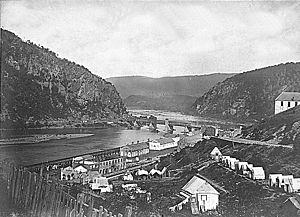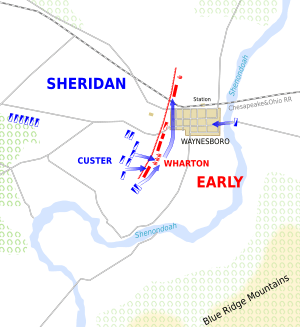Kenton Harper facts for kids
Quick facts for kids
Kenton Harper
|
|
|---|---|
| Member of the Virginia House of Delegates from Augusta County | |
| In office December 5, 1836-December 311837 |
|
| Preceded by | John J. Craig |
| Succeeded by | William Kinney |
| Personal details | |
| Born | 1801 Chambersburg, Pennsylvania |
| Died | December 25, 1867 (aged 65–66) Staunton, Virginia |
| Resting place | Thornrose Cemetery in Staunton |
| Military service | |
| Allegiance | |
| Branch/service | |
| Years of service | 1846–48 (USA) 1861–64 (CSA) |
| Rank | Major General (Virginia militia) Brigadier General (Va. Provisional Army) |
| Battles/wars | Mexican–American War American Civil War |
Kenton Harper (born in 1801, died December 25, 1867) was an American who did many things. He was a newspaper editor, a soldier, a banker, and a politician. He also owned a large farm.
Harper served as an officer in the United States Army during the Mexican–American War. Later, he became a general for the Confederate States of America during the American Civil War. People say he even helped give the famous nickname to General Stonewall Jackson.
Contents
Early Life and Family
Kenton Harper was born in 1801 in Chambersburg, Pennsylvania. His father, George Kenton Harper, published a newspaper called the Franklin County Repository. His mother was Nancy McClintock.
Harper married Ellen Calhoun. They had four children: two sons named Samuel and George Kenton, and two daughters named Nancy and Mary. Ellen's sister, Catherine Calhoun, also lived with their family.
Harper's son, Samuel C. Harper (1831-1901), also fought in the Confederate Army. He joined on August 6, 1862, and became a quartermaster sergeant. This meant he helped manage supplies for the 62nd Virginia Infantry. Like his father, Samuel survived the war.
Newspaper Work and Politics
When he was young, Harper worked as a printer in Chambersburg. In 1823, he moved to Staunton, Virginia, in the Shenandoah Valley. There, he bought a local newspaper called the Republican Farmer.
Over time, this newspaper became known as the Staunton Spectator. Harper published this paper until 1849. In 1836, people in Staunton and Augusta County, Virginia elected Harper to represent them. He served in the Virginia House of Delegates, which is like a state parliament. He was elected alongside Alexander H.H. Stuart. However, Harper did not win re-election. Later, he was elected as the mayor of Staunton.
Military Service Before the Civil War
During the Mexican–American War, Harper became a captain in the 1st Virginia Infantry. He led a group of volunteers from Augusta County. They served in the northern part of Mexico. Harper did not fight in any battles during this war. He returned home in August 1848.
After the war, Harper was appointed as an acting inspector general for his military group. He also served as the military governor of Parras de la Fuente in Mexico. In 1860, Harper was made a major general in Virginia's state militia.
From 1851 to 1852, Harper worked for the United States government. He was an agent to the Chickasaw people at Fort Washita. Later, he became an assistant to the United States Secretary of the Interior in Washington, D.C. He also served as the president of a bank in the Staunton area.
American Civil War Role

When the Civil War started in 1861, Kenton Harper chose to support the Confederate States of America. He was still a major general in Virginia's state militia. On April 10, he was given command of the 5th Virginia Infantry Regiment.
Eight days later, Harper led about 2,400 men with General William H. Harman. They took over the U.S. Army arsenal at Harpers Ferry, West Virginia. The Union Army had set fires as they left. But Harper's militia saved many things. They rescued 4,000 muskets (rifles) and 300 machines used to make guns. They also saved about 57,000 tools and wooden rifle parts. All these items were sent to the Tredegar Iron Works in Richmond, Virginia, to help make more weapons.
On April 28, Confederate Colonel Stonewall Jackson arrived to take command at Harpers Ferry. He began to organize the militia groups into larger units called regiments.
On May 1, 1861, Harper was made a brigadier general in the Virginia Provisional Army. This army soon joined the main Confederate States Army. Seven days later, he became a colonel and was given command of the 5th Virginia Infantry. This regiment was part of the famous Stonewall Brigade.
Harper and the 5th Virginia fought well at the First Battle of Bull Run on July 21. His skills as a soldier were noticed by the army commander. However, Harper left the Confederate Army on September 11. This was because General Jackson would not let him go home to his wife, who was very sick.

After leaving the army, Harper returned to the Shenandoah Valley. Voters in Augusta County again elected him to the Virginia House of Delegates. He served there until 1864.
On June 2, 1864, Harper rejoined the Confederate Army as a colonel. He formed a new regiment from reserve companies in the Shenandoah Valley. During the Valley campaigns of 1864, Confederate soldiers destroyed Harper's hometown of Chambersburg, Pennsylvania. This was in response to Union attacks in the valley.
Colonel Harper and his troops fought under General Jubal Early. They were defeated at the Battle of Piedmont in June 1864. They were also defeated at the Battle of Waynesboro, Virginia on March 2, 1865. This was one of the last battles of the war.
After the War
After the Civil War ended, Harper went back home to Staunton in 1865. Two years later, he died on Christmas Day, December 25, 1867. He passed away from pneumonia at his farm, "Glen Allen." He was buried in Staunton's Thornrose Cemetery.
During his life, it is said that Harper helped General Barnard Elliott Bee Jr. notice Stonewall Jackson's actions at the First Battle of Bull Run. This led to Jackson getting his famous nickname, "Stonewall."

